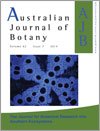Australian Journal of Botany
Volume 62
Number 7 2014
Australia has several species of invasive (weedy) cucurbit species that have similar growth habits (sprawling vines) but have different growth cycles (annuals and perennials). We examined the taproot of annuals (two species) and a perennial (one species) and found that the annuals had small diameter taproots with relatively large diameter vessels, while the perennial had a large diameter taproot with smaller diameter vessels and a large volume of parenchyma. The taproot of the annuals was primarily constructed to conduct water through a relative small diameter cylinder while the perennial taproot had dual functions of water conduction and storage of starch to fund resprouting.
Ecological restoration of land affected by mining is often required post-mining. This requires production of seedlings of local species, for which germination requirements are often unknown. Therefore, we investigated seed dormancy and methods to break seed dormancy in three Australian arid-zone plant species. Restoration practitioners can use these methods, including scarification and wet-heat application, to overcome seed dormancy before direct seeding, to ensure seeds are capable of germinating readily.
The efficiency by which nutrients are used by forests (nutrient use efficiency, or NUE) is an important indicator of ecosystem functioning, particularly the hypothesis that where nutrients are less available, forests are more efficient in their nutrient use. This study evaluates the value of different NUE indices and surrogates for one species, Eucalyptus pilularis, and shows that the hypothesis is true but forest age has to be taken into account. Suitable indices have been identified for comparison of NUEs among forest types important in both the cycling of nutrients and as a factor in the delineation of species in the landscape.
The removal of livestock grazing can improve the condition of grassland vegetation by allowing native plant growth and plant litter to accumulate. Experiments over a 4-year period showed that growing conditions can be additionally improved by reducing kangaroo densities and providing additional fallen timber. However, in the short term, favourable seasonal conditions can be the most important factor driving plant growth and increasing apparent plant diversity, particularly after a period of drought.
Leaf samples of Microlaena stipoides were collected from a pasture in north-eastern Victoria. The genetic diversity among samples was analysed using amplified fragment length polymorphism (AFLP) markers. These results indicated that the populations studied are likely to have undergone some degree of outcrossing (Fst = 0.0219). It is likely that recruitment is occurring from sexual reproduction as well as via clonal spread.
Phytophthora cinnamomi is a Key Threatening Process to the Australian environment, yet its interaction with fire is poorly understood. In south-western Australian heathlands, the proportion of dead and dying individuals of plants susceptible to P. cinnamomi was best explained by latest fire interval and average fire interval. This suggests that fire increases P. cinnamomi activity, which further complicates conservation management’s development of fire regimes for the conservation of biodiversity and the reduction of damaging wildfires.
Shrubs and shrublands provide important ecosystem services, such as habitat for plants and animals and the maintenance of healthy, productive soils. Dense patches of shrubs, however, are often regarded as a sign of a dysfunctional system. We question this paradigm by reviewing scientific evidence and conclude that the condition of shrublands relates more to how they are managed than to the presence of shrubs themselves. Well managed shrublands can support a sustainable grazing industry as well as capturing and retaining nutrients, water and C, and providing plant and animal habitat.
Until recently, ‘Eyres Green’ was the only commercial oldman saltbush cultivar available in Australia for use in rehabilitating salt-affected and arid agricultural lands and to provide feed for livestock. This study used genetic markers to identify the plant source of ‘Eyres Green’ for land managers, so they can evaluate effective use of the cultivar in farming systems.
A novel mass-propagation method for Australian terrestrial orchids species is at hand. With seed of rare species in short supply the aim of this research was to develop a special tissue culture method enabling cloning of multiple copies of the early stages of germinated orchid seeds that maximises the number of plants produced from each seed. This more efficient method will significantly assist orchid conservation programs.




